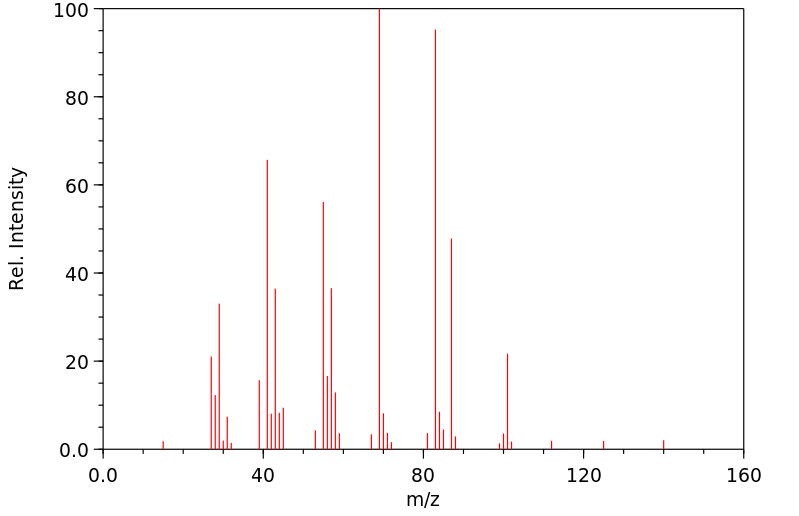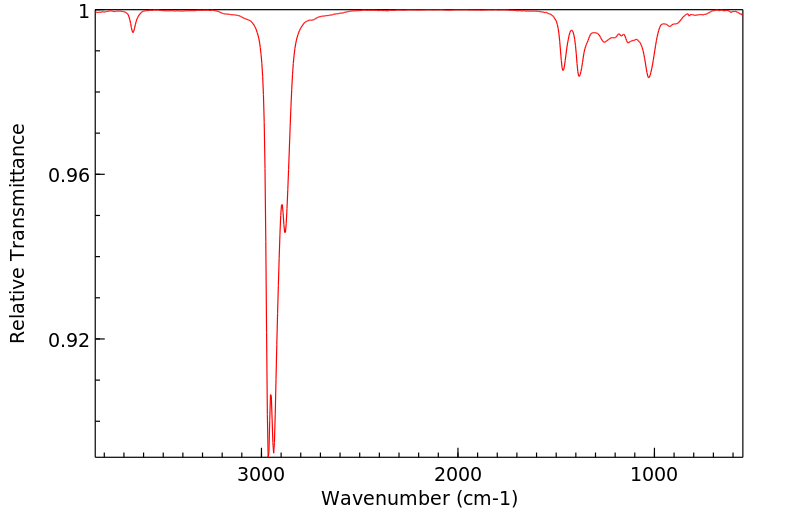2-甲基-5-壬醇 | 29843-62-7
中文名称
2-甲基-5-壬醇
中文别名
——
英文名称
2-methyl-5-nonanol
英文别名
2-methylnonan-5-ol
CAS
29843-62-7
化学式
C10H22O
mdl
——
分子量
158.284
InChiKey
RLQVUGAVOCBRNQ-UHFFFAOYSA-N
BEILSTEIN
——
EINECS
——
-
物化性质
-
计算性质
-
ADMET
-
安全信息
-
SDS
-
制备方法与用途
-
上下游信息
-
文献信息
-
表征谱图
-
同类化合物
-
相关功能分类
-
相关结构分类
物化性质
-
熔点:-1.53°C (estimate)
-
沸点:213.4°C (estimate)
-
密度:0.8170
计算性质
-
辛醇/水分配系数(LogP):3.5
-
重原子数:11
-
可旋转键数:6
-
环数:0.0
-
sp3杂化的碳原子比例:1.0
-
拓扑面积:20.2
-
氢给体数:1
-
氢受体数:1
SDS
反应信息
-
作为反应物:描述:2-甲基-5-壬醇 以35%的产率得到参考文献:名称:ROSCHER, N. M.;SHAFFER, D. K., TETRAHEDRON, 1984, 40, N 14, 2643-2650摘要:DOI:
-
作为产物:描述:参考文献:名称:Powell; Hagemann, Journal of the American Chemical Society, 1944, vol. 66, p. 374摘要:DOI:
文献信息
-
[EN] PROCESS<br/>[FR] PROCÉDÉ申请人:PHOSPHAGENICS LTD公开号:WO2018112512A1公开(公告)日:2018-06-28An efficient and commercial phosphorylation process of a complex alcohol, such as secondary and tertiary alcohols, with P4O10 at high temperatures, and a product obtained by the process.
-
Iron(II)-Catalyzed Site-Selective Functionalization of Unactivated C(sp<sup>3</sup> )−H Bonds Guided by Alkoxyl Radicals作者:Honghao Guan、Shutao Sun、Ying Mao、Lei Chen、Ran Lu、Jiancheng Huang、Lei LiuDOI:10.1002/anie.201806434日期:2018.8.27for site‐selective functionalization of unactivated methylene and methine C−H bonds enabled by an FeII‐catalyzed redox process is described. The mild, expeditious, and modular protocol allows efficient remote aliphatic fluorination, chlorination, amination, and alkynylation of structurally and electronically varied primary, secondary, and tertiary hydroperoxides with excellent functional‐group tolerance
-
Selectivity of tetrahydrofuran formation from inactivated aliphatic alcohols by the bromine-silver-salt reaction作者:Nina Matheny Roscher、D. Kent ShaffarDOI:10.1016/s0040-4020(01)96881-4日期:1984.1Studies of the bromine-silver carbonate reaction with aliphatic alcohols in which intramoleular δ-H competition is possible are generally quite specific. Loss of tertiary δ- hydrogen occurs preferentially from both tertiary and secondary alfphatic alcohols to yield the most highly substituted cyclic ether. For example, 2,5-dimethyl-2-octanol yields only 2,2,5-trimethyl-5-propyletrahydrofuran as the
-
Compositions and Methods for Fermentation of Biomass申请人:Parekh Sarad公开号:US20100268000A1公开(公告)日:2010-10-21In one aspect, this invention relates to production of useful fermentation end-products from biomass through simultaneous hydrolysis and fermentation by a microorganism, such as Clostridium phytofermentans . The invention also relates to the development of a process for efficient pretreatment and conversion of lignocellulosic biomass to end-products with high conversion efficiency (yield). In another aspect, methods for producing a fermentation end-product by fermenting hexose (C6) and pentose (C5) sugars with a microorganism, such as Clostridium phytofermentans are disclosed herein.
-
BIOFUEL PRODUCTION申请人:Yoshikuni Yasuo公开号:US20090139134A1公开(公告)日:2009-06-04Methods, enzymes, recombinant microorganism, and microbial systems are provided for converting polysaccharides, such as those derived from biomass, into suitable monosaccharides or oligosaccharides, as well as for converting suitable monosaccharides or oligosaccharides into commodity chemicals, such as biofuels. Commodity chemicals produced by the methods described herein are also provided. Commodity chemical enriched, refinery-produced petroleum products are also provided, as well as methods for producing the same.
表征谱图
-
氢谱1HNMR
-
质谱MS
-
碳谱13CNMR
-
红外IR
-
拉曼Raman
-
峰位数据
-
峰位匹配
-
表征信息
同类化合物
(反式)-4-壬烯醛
(s)-2,3-二羟基丙酸甲酯
([1-(甲氧基甲基)-1H-1,2,4-三唑-5-基](苯基)甲酮)
(Z)-4-辛烯醛
(S)-氨基甲酸酯β-D-O-葡糖醛酸
(S)-3-(((2,2-二氟-1-羟基-7-(甲基磺酰基)-2,3-二氢-1H-茚满-4-基)氧基)-5-氟苄腈
(R)-氨基甲酸酯β-D-O-葡糖醛酸
(5,5-二甲基-2-(哌啶-2-基)环己烷-1,3-二酮)
(2,5-二氟苯基)-4-哌啶基-甲酮
龙胆苦苷
龙胆二糖甲乙酮氰醇(P)
龙胆二糖丙酮氰醇(P)
龙胆三糖
龙涎酮
齐罗硅酮
齐留通beta-D-葡糖苷酸
鼠李糖
黑芥子苷单钾盐
黑海棉酸钠盐
黑木金合欢素
黑曲霉三糖
黑介子苷
黄尿酸8-O-葡糖苷
麻西那霉素II
麦迪霉素
麦芽糖脎
麦芽糖基海藻糖
麦芽糖1-磷酸酯
麦芽糖
麦芽四糖醇
麦芽四糖
麦芽十糖
麦芽六糖
麦芽五糖水合物
麦芽五糖
麦芽五糖
麦芽五糖
麦芽三糖醇
麦芽三糖
麦芽三糖
麦芽三塘水合
麦芽七糖水合物
麦芽七糖
麦法朵
麦可酚酸-酰基-Β-D-葡糖苷酸
麦利查咪
麝香酮
鹤草酚
鸢尾酚酮 3-C-beta-D-吡喃葡萄糖苷
鸡矢藤苷








